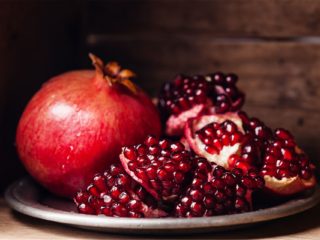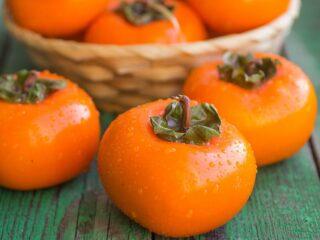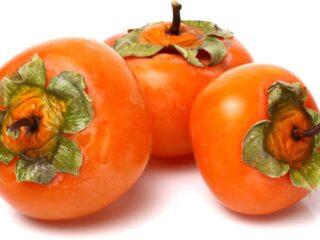Content
- 1 What is the name of dried persimmon
- 2 What is the difference between dried persimmon and fresh
- 3 How many calories are in dried persimmon
- 4 Why is dried (dried) persimmon useful?
- 5 How to eat dried (dried) persimmons
- 6 Are dried persimmons washed before use?
- 7 The use of dried persimmon in medicine
- 8 The use of dried persimmon in cooking
- 9 Harm and contraindications
- 10 How to choose dried (dried) persimmon
- 11 Conclusion
Dried persimmon is a healthy product that retains all the properties of a fresh berry. You can buy it at the store or prepare it yourself. Before use, the pieces are washed and, if necessary, softened in warm water. Used for the preparation of drinks, as well as in folk medicine (inside and outside).
What is the name of dried persimmon
Dried persimmon is a processed product of fresh fruits, which is obtained by drying or drying in the open air or in a ventilated area. In many southern countries, for example, in Georgia, dried persimmon is called "chiri". This is a popular sweet snack served on the New Year's table.
Dried and dried persimmons are often considered the same product, which is partly true. They differ only in the technology of preparation: the dried one is put in the oven, and the dried one is hung to the ceiling in a ventilated room or outdoors under a canopy. In this case, the dried product is stored for up to 2 years, and dried - up to 3 (in a cool, dry and dark place).
What is the difference between dried persimmon and fresh
Dried fruits look different compared to fresh persimmons. A white bloom appears on their surface - this is sugar, indicating the good quality of the product. There are other differences as well:
- high calorie content - 4 times more;
- rich taste with tangible sweetness;
- pronounced aroma;
- the consistency is denser, although not too hard;
- shelf life up to three years (for fresh fruit up to six months in the cellar).
How many calories are in dried persimmon
The calorie content of dried persimmon per 100 grams of the finished product is 303 kcal, i.e. it is a high-calorie product. For comparison: in the pulp of fresh or frozen fruit, 67 kcal for the same mass. This is explained by the fact that during drying or curing, the pulp loses water, which makes up a significant part of its weight and does not contain any calories.
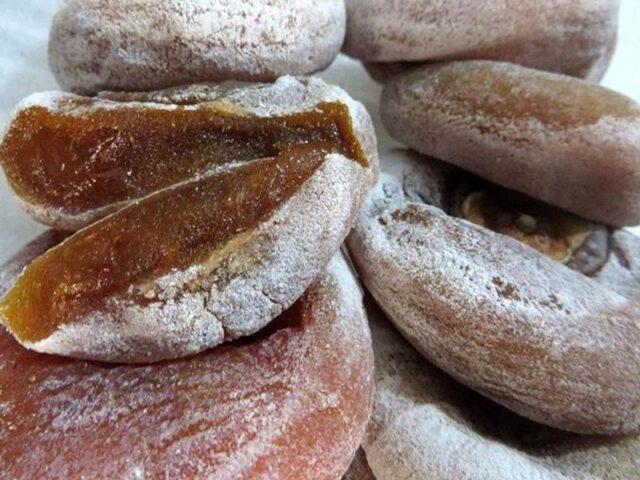
Dried persimmons are coated with sugar
Nutritional value (per 100g):
- proteins - 1.4 g;
- fats - 0.6 g;
- carbohydrates - 73 g.
You need to use the dried product with caution, since the calorie content of 100 g is equivalent to one full meal. Moreover, all carbohydrates that make up the fruit are simple. They quickly give energy, but do not saturate the body for a long time. Within an hour, the feeling of hunger will again appear.
Why is dried (dried) persimmon useful?
The benefits of dried persimmon for women and men are determined by the rich chemical composition. Due to the fact that drying is done in gentle conditions (at a low temperature), almost all useful substances are preserved in the pulp:
- macronutrients (potassium, phosphorus, sodium);
- trace elements (magnesium, iron, manganese, iodine);
- vitamins (C, P, E, A, group B, beta-carotene);
- organic acids (citric, malic, betulinic);
- cellulose;
- pectins;
- simple carbohydrates (sucrose, glucose).
If you regularly consume dried persimmon, you can not only saturate the body with energy (use it as a snack in limited quantities), but also get the necessary vitamins and other substances. It benefits the human body. Reception of persimmon:
- enhances metabolism;
- neutralizes the effect of alcohol (ethyl alcohol);
- improves digestion;
- reduces bleeding (with hemorrhoids);
- restores vascular tone and normalizes heart function;
- removes harmful components, including products of metabolic reactions, slags;
- improves blood circulation (prevention of anemia);
- strengthens the immune system.
The fruits have the following properties:
- anti-inflammatory;
- anti-cancer (thanks to rare betulinic acid);
- antiseptic (for the treatment of skin diseases).
The benefits of dried persimmon for a woman's body have also been studied. For example, due to the regular use of this product, you can quickly saturate the body with energy so as not to overload with extra calories before the main meal. In addition, persimmons contribute to the health of nails, hair and skin.
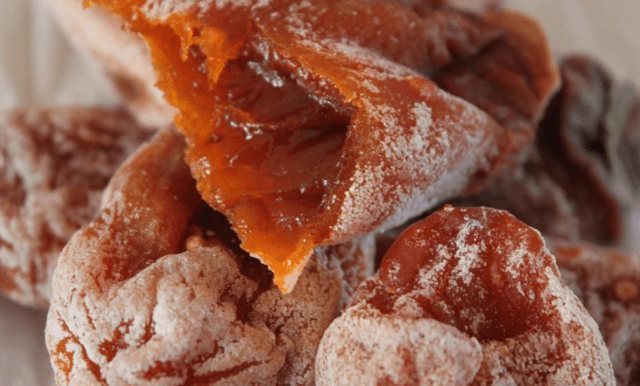
Dried persimmon is a healthy but high-calorie product
Another positive property is that fruits help to cope with puffiness during late pregnancy. Therefore, they can be consumed in moderation (in the absence of such contraindications as diabetes mellitus and allergies).
Persimmons can be used for cosmetic masks. To do this, it is better to take not dried pulp, but unripe fruits, which noticeably knit in taste. The pulp is crushed, mixed with the yolk of an egg and a few drops of lemon juice and applied to the face for 30 minutes.
How to eat dried (dried) persimmons
If the berry was harvested recently, its consistency is quite soft. Therefore, it can be eaten without presoaking. But most often, dried persimmons need to be softened. To do this, put it in warm water (40-50 degrees) for 40-60 minutes (pour it so that only to cover the surface). If you have time, you can leave it overnight, covered with a plate. Then the pulp will become very soft and at the same time will not lose its taste and aroma.
You can also soak dried persimmon for baking. If you cook compote or another drink, you do not need to do this - the pieces will still soften during the cooking process.
Are dried persimmons washed before use?
If the product is well packaged, and even more so prepared by yourself, it is not necessary to wash it. But if you are not sure, it is better to rinse under running water or lightly pour over boiling water. This method allows you to destroy almost all bacteria and other dangerous microorganisms.
The use of dried persimmon in medicine
In folk medicine, the product is used to cleanse the intestines, improve digestion, and as an expectorant. Despite the high calorie content, dried fruits are also used in dietetics: they replace breakfast or add pieces to oatmeal along with figs, dates and other dried fruits.

Dried persimmons can be used to treat diarrhea, sore throats, and colds
There are several recipes for treating diseases:
- For diarrhea, take 100 g of pulp and boil in 500 ml of water. After boiling, stand for 30 minutes on low heat. Drink the entire portion per day, in equal doses of half a glass.
- For colds and sore throats, take 100 g of pulp, pour it with warm water to soften, then turn it into gruel using a blender or meat grinder. Add a little water, filter. You need to gargle with this hood 4-5 times a day.
- For the treatment of boils and abscesses, several pieces are softened, turned into gruel and placed on the affected area. Cover with cotton wool and bandage for 5-6 hours.
The use of dried persimmon in cooking
Most often, the dried product is not used in its pure form, but for the preparation of compotes. The classic recipe requires 3 ingredients:
- water - 2 l;
- dried persimmon - 900 g;
- sugar - 200-300 g
Step-by-step instruction:
- Pour cold water, add sugar.
- Bring to a boil over low heat.
- Cut the fruits into equal pieces, add to the water while boiling.
- Cook over medium heat for 7 minutes.
- Cover and let it brew until it cools completely.
For the holiday, you can prepare a warming drink based on the following ingredients:
- water - 1.5 l;
- dried persimmon - 700 g;
- lemons - 2 pcs.;
- rum - 500 ml (less is possible);
- ground ginger - 10 g;
- carnation - 5 flowers;
- sugar - 200 g;
- cinnamon - 1-2 sticks.
The cooking instructions are as follows:
- Put sugar in water, bring to a boil.
- Add cloves, cinnamon, ginger and pre-cooked lemon zest.
- Simmer the mixture over low heat for 20 minutes.
- Add rum and freshly squeezed lemon juice to the hot broth, cover and leave for 20-30 minutes.
Harm and contraindications
The main harm of this product is its high calorie content. The pulp contains substances that are allergens to some people. Therefore, use should be limited if you have:
- diabetes;
- excess weight;
- intestinal obstruction;
- chronic diseases of the pancreas (especially during an exacerbation);
- recent abdominal surgery;
- allergies.
During pregnancy and lactation, the fruits are consumed with caution. For children under 3 years old, the product should be excluded from the diet.

For patients with diabetes, constipation, the use of the product should be limited
But even if you have diabetes, the fruit can be included in your diet in a minimal dose (for example, 50–70 g per day). The patient should monitor his condition and, as soon as necessary, refuse dessert and consult a doctor.
How to choose dried (dried) persimmon
When buying a product, you should pay attention to the manufacturer and the appearance:
- there should be a white coating on the surface;
- if it is easily erased, it is flour or starch - a sign of a low-quality fruit;
- the consistency of dried persimmons should be like rubber (not too dry, rather soft);
- there are no dots, blotches and other extraneous spots.
Dried dried persimmons are stored in the refrigerator or in the basement. The room should be dark and cool, and most importantly, moderately damp. In such conditions, the shelf life will be up to 2-3 years (from the date of production), but it is better to use it within a year.
Conclusion
Dried persimmon is a healthy product that quickly saturates and energizes. The pulp contains vitamins, minerals and antioxidants. The calorie content of the fruits is very high - more than 300 kcal per 100 g. Therefore, even healthy people should limit the use of dried persimmon.



